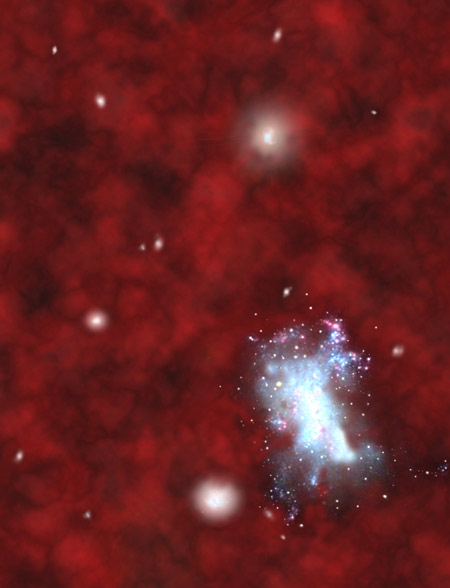The End of Small Galaxies

When the universe was young, countless dwarf galaxies formed, heating the universe and preventing the formation of more small galaxies, a new study suggests.
The Big Bang, a theoretical beginning to the universe, is thought to have generated lots of hot stuff--electrons and hydrogen and helium ions. The material expanded rapidly. As space expanded, matter cooled, and the electrons and ions formed neutral atoms and absorbed surrounding light.
This placed a dark curtain throughout space. The shadowy era is called the Dark Ages.
The Dark Ages ended when the first stars and galaxies formed and began to shine. Their light stripped electrons from neutral gases in the universe and produced charged ions, a process called reionization.
During this time, the gas reionized and also heated.
Hot gas does not easily clump together to form stars and galaxies. If gas is very hot, you need a very massive collection of it with strong gravitational pull to attract enough additional matter to create a seed from which a galaxy can form.
Before the period of reionization, galaxies containing only 100 million solar masses of material could form easily. After this period however, more than 10 billion solar masses of material had to be assembled to make a galaxy.
Get the Space.com Newsletter
Breaking space news, the latest updates on rocket launches, skywatching events and more!
Therefore, the theory states that the formation of dwarf galaxies--containing up to several billion stars--would have been suppressed during this era in favor of more massive collections of stars.
"Although this was theoretically known, it was not proven," said Stuart Wyithe of the University of Melbourne's School of Physics. "We now have evidence that this occurred at the end of a period called the 'Dark Ages', when the unstructured elements in space evolved under gravity into the universe we see today."
The researchers determined the masses of early galaxies by looking at the light emitted by quasars, very distant galaxies with bright cores powered by supermassive black holes. In the early universe, clouds of hydrogen absorbed the light from quasars. If there are larger and fewer galaxies, there is more variation in the absorption seen across various lines of sight.
"As an analogy, suppose you are in a room where everybody is talking," Wyithe explained. "If this room is sparsely populated, then the background noise is louder in some parts of the room than others. However if the room is crowded, then the background noise is the same everywhere."
'The fact that we see fluctuations in the light from quasars implies that the early universe was more like the sparse room than the crowded room. We found that fluctuations in light from quasars implied that the early universe was sparsely populated," Wyithe said.
The study was detailed in last week's issue of the journal Nature.
- Most Distant Galaxy Hints at Dark Ages
- The First Stars: Stellar Ashes Reveal Timing of Initial Light
- After the Big Bang, the Big Snowstorm
- GALLERY: Your Cosmic Images
Join our Space Forums to keep talking space on the latest missions, night sky and more! And if you have a news tip, correction or comment, let us know at: community@space.com.










